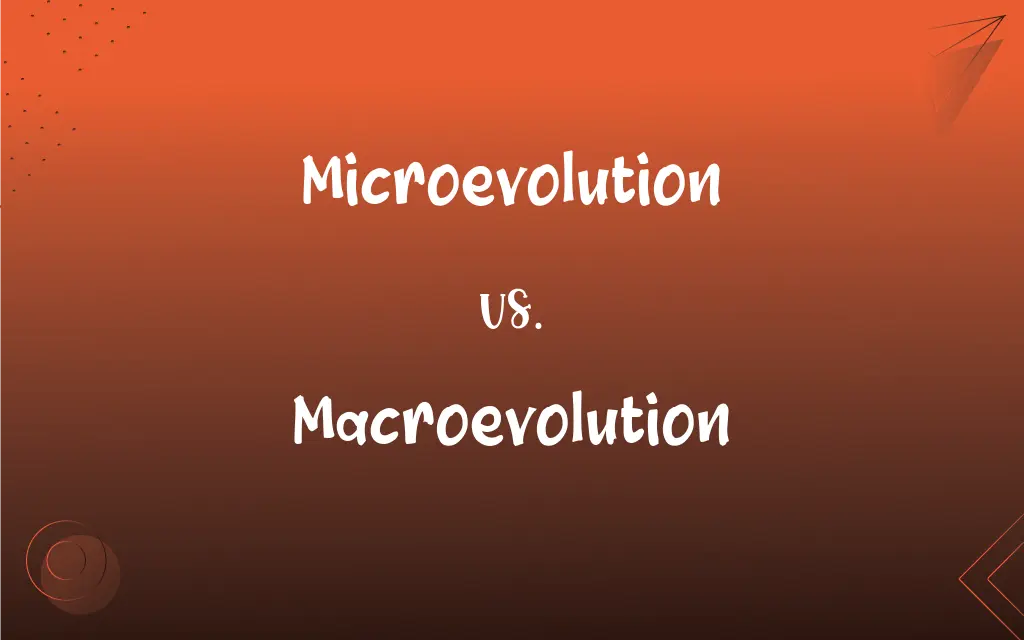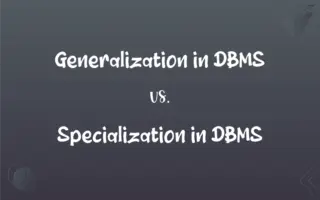Microevolution vs. Macroevolution: What's the Difference?
Edited by Janet White || By Harlon Moss || Updated on October 28, 2023
Microevolution involves small-scale changes in gene frequencies within a population; macroevolution encompasses large-scale evolutionary changes leading to new species over geologic time.

Key Differences
Microevolution and macroevolution are fundamental concepts in evolutionary biology that address change on different scales. Microevolution refers to the small-scale genetic changes that occur within a population, which can lead to variations over relatively short periods. These changes are driven by mechanisms like mutation, gene flow, genetic drift, and natural selection. On the other hand, macroevolution encompasses larger-scale evolutionary changes that typically occur over long geologic time frames, leading to the emergence of new species, genera, or even higher taxonomic groups.
While microevolution focuses on changes at the genetic level within populations, macroevolution considers the broader picture, examining the patterns of descent over extended periods. Microevolution can be observed within a few generations, such as antibiotic resistance in bacteria or changes in finch beak size on the Galápagos Islands. Macroevolution, however, delves into phenomena like speciation events, extinctions, and the broad evolutionary trends that shape the history of life on Earth.
Another distinguishing feature is the scale of observation. Microevolutionary changes are often evident within single populations or species and can be directly observed and measured in real-time or through the study of recent history. Macroevolutionary patterns and processes, conversely, are typically inferred from the fossil record, comparative anatomy, and molecular data, giving insights into the deeper history of life.
Though microevolution and macroevolution operate on different scales, they are not isolated from one another. The accumulation of microevolutionary changes can, over prolonged periods, lead to macroevolutionary outcomes. For instance, the small genetic shifts within populations (microevolution) might, over millions of years, result in significant divergence and the emergence of entirely new species (macroevolution).
It's essential to recognize that both microevolution and macroevolution are integral parts of the evolutionary process. They offer complementary perspectives, with microevolution illuminating the immediate genetic dynamics within populations, and macroevolution providing a broader view of life's diversity and history.
ADVERTISEMENT
Comparison Chart
Scale
Small-scale changes within populations
Large-scale changes leading to new species or higher taxa
Time Frame
Short periods (generations to thousands of years)
Long geologic time frames (millions to hundreds of millions of years)
Observation
Direct observation in real-time or recent history
Inferred from fossil record, comparative anatomy, and molecular data
Outcome
Variations within species
Emergence of new species, genera, and higher taxonomic groups
Mechanisms
Mutation, gene flow, genetic drift, natural selection
Speciation, extinction, broad evolutionary trends
ADVERTISEMENT
Microevolution and Macroevolution Definitions
Microevolution
Small-scale evolutionary changes observed over short periods.
The varying beak sizes among Galápagos finches are evidence of microevolution in action.
Macroevolution
Evolutionary change above the species level.
The divergence of mammals and reptiles is an example of macroevolution.
Microevolution
Variations within a species due to genetic shifts.
Microevolutionary processes can lead to diverse traits even within the same species.
Macroevolution
Evolutionary changes producing new species or higher taxa.
The emergence of flowering plants from non-flowering ancestors is a macroevolutionary event.
Microevolution
Evolution at or below the level of species.
The spread of a beneficial trait within a fish population is a microevolutionary response to predation.
Macroevolution
Large-scale evolutionary patterns and trends over geologic time.
The rise and fall of the dinosaurs are explored through the lens of macroevolution.
Microevolution
Evolutionary changes governed by mechanisms like mutation and selection.
Due to environmental pressures, microevolution led to thicker fur in a particular wolf population.
Macroevolution
Patterns of descent observed over extended evolutionary timeframes.
Through macroevolution, we understand the common ancestry of vertebrates.
Microevolution
Changes in allele frequencies within a population over time.
The increasing resistance of bacteria to antibiotics is a result of microevolution.
Macroevolution
Processes leading to speciation, extinction, and broad evolutionary shifts.
Macroevolutionary studies highlight the transitions from aquatic to terrestrial life.
Microevolution
Small-scale evolution consisting of genetic changes occurring usually within a single species and over a shorter period of time than in macroevolution.
Macroevolution
Large-scale evolution occurring over a very long period time that results in the formation of new species and higher-level taxonomic groups.
Microevolution
Small-scale changes in the history of life, such as changes in allele frequencies in a population (over a few generations); also known as change at or below the species level.
Macroevolution
Large-scale patterns or processes in the history of life, including the origins of novel organism designs, evolutionary trends, adaptive radiations and extinctions.
Microevolution
Evolution resulting from small specific genetic changes that can lead to a new subspecies
Macroevolution
Evolution on a large scale extending over geologic era and resulting in the formation of new taxonomic groups
FAQs
How is microevolution different from macroevolution?
Microevolution involves small-scale changes within populations, while macroevolution refers to larger-scale changes leading to new species over long periods.
What is microevolution?
Microevolution refers to small-scale evolutionary changes within a population over a short period of time.
What causes microevolution?
Factors like genetic drift, gene flow, mutation, and natural selection can cause microevolution.
Can microevolution lead to new species?
On its own, not necessarily, but accumulated microevolutionary changes can contribute to macroevolutionary processes.
Are all microevolutionary changes beneficial?
Not necessarily; changes can be beneficial, neutral, or harmful.
Is macroevolution controversial?
While macroevolution is widely accepted in the scientific community, it's sometimes debated in certain non-scientific circles.
How does genetic drift contribute to microevolution?
It's the random change in allele frequencies in a population, influencing evolutionary changes.
Can macroevolution be observed directly?
Due to its long timeframe, it's typically inferred from fossil records and comparative studies rather than directly observed.
Do microevolution and macroevolution always occur independently?
No, they can and often do influence each other, with microevolutionary changes accumulating to drive macroevolutionary shifts.
Is microevolution observable?
Yes, it can be observed over short periods, often within a human lifespan.
What role do extinction events play in macroevolution?
Extinctions can pave the way for new evolutionary pathways by eliminating dominant species.
Is speciation a macroevolutionary process?
Yes, speciation, or the formation of new species, is a fundamental aspect of macroevolution.
How do adaptive radiations relate to macroevolution?
Adaptive radiations, where species rapidly diversify to fill niches, are significant macroevolutionary events.
What's an example of microevolution?
Antibiotic resistance in bacteria is a classic example.
How do mutations fit into microevolution?
Mutations introduce genetic variability, which can be acted upon by natural selection or other evolutionary forces.
What is macroevolution?
Macroevolution refers to large-scale evolutionary changes that lead to the emergence of new species or higher taxonomic groups over long periods.
What's an example of macroevolution?
The evolution of birds from theropod dinosaurs is a cited example.
How do punctuated equilibrium and gradualism fit into macroevolution?
These are theories about the pace of evolution; punctuated equilibrium suggests rapid changes at times, while gradualism proposes slow, consistent change.
Is macroevolution just extended microevolution?
It's debated, but many believe that accumulated microevolutionary changes can lead to macroevolutionary events.
Is artificial selection a form of microevolution?
Yes, it's human-induced selection, leading to changes within a population.
About Author
Written by
Harlon MossHarlon is a seasoned quality moderator and accomplished content writer for Difference Wiki. An alumnus of the prestigious University of California, he earned his degree in Computer Science. Leveraging his academic background, Harlon brings a meticulous and informed perspective to his work, ensuring content accuracy and excellence.
Edited by
Janet WhiteJanet White has been an esteemed writer and blogger for Difference Wiki. Holding a Master's degree in Science and Medical Journalism from the prestigious Boston University, she has consistently demonstrated her expertise and passion for her field. When she's not immersed in her work, Janet relishes her time exercising, delving into a good book, and cherishing moments with friends and family.







































































